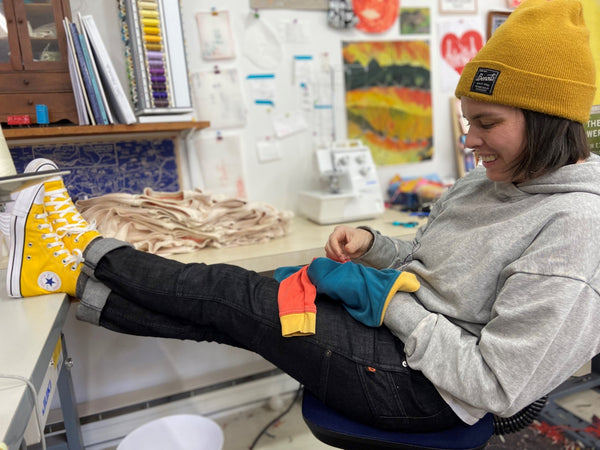Get Mending: 3 Tips to Ditch Fast Fashion and Textile Waste
Mar 13, 2023
March 2023
You see a shirt you like, you buy it, wear it a few times and as the fabric starts to fray, you toss it out, right? It's easy to do in a world where big box stores display inexpensive clothes that we have no connection or loyalty to. You might say “Hey, I can buy another”!
So how can you become a reusable water bottle-type hero in this single-use clothing world?
YOU MEND.
This is not a fad, though its popularity in fashion and sustainable living culture is back on the rise.
People have been mending clothes all over the world, for centuries. In fact, one of the oldest examples of visible mending is sitting in a museum in Manchester, England. Check out this mended Egyptian tunic, dated 600-700 B.C.!
And in Japan, the embroidery style called sashiko (translation: little stabs) can be traced back to the 1600s.

Our ancestors have long been mending to increase the sturdiness of clothing, prolong a garment's use and stretch a valuable resource out as far as it could go. This was especially important during times when materials were scarce or too expensive for working-class families to afford.
Flash forward to now, the more things change the more things stay the same! Visible mending is definitely becoming popular again, especially with people that are conscious of their environmental impact. It also remains as valuable as ever for folks that don’t have flexibility in their budget to buy new at every minor hole or stain.
Maybe you identify with one or both of these situations but feel a little overwhelmed at the idea of mending your own clothes. If so, here are a couple of sobering stats about clothing waste to consider before you throw away the idea of mending and head to the trash can with that pair of pants.
According to earth.org, the average person throws away about 81.5 lbs of clothing per year which makes for a global deposit of 92 million tons of textiles ending up in landfills a year. Yep, you read that right — that was millions of tons a year!
I’m not even sure that I have 81.5 pounds of clothes, but WOW. That number is astonishing.
Not sure what 81.5 pounds of clothing look like? It’s the size of a full-grown orangutan to give you a visual. Over the course of one person's lifetime, that's a lot of orangutans.
Where is all this textile waste coming from (besides the folks who are chucking it in the trash)? From the fashion industry.¹
According to an article by the Public Research Interest Group, the fashion industry is the world’s second worst offender when it comes to water and plastic pollution and contributes roughly 10% of all global carbon emissions. The site goes on to note that every second, a dump truck-sized load of clothing and textile material is sent to an incinerator or a landfill the world over.²
If these shocking stats weren’t enough, author Kim P. of Credit Donkey writes: “Families bringing home the average $64,175 annually spend around $2,440 on clothing per year”.³
So if you’re bummed now between planet impact stats and wallet impact stats of your family's clothing habits, don’t lose heart! There are many ways to decrease your textile waste and today we’re gonna talk about one of them: MENDING.
Now before you say: “I don't have the time my granny had to sit around by the fire and darn woolens” hear me out.
Mending does not have to be time-consuming or difficult, in fact, it can be quick, creative, and fun! If you can thread a needle, you can mend your clothes!
So if you are new to mending, here are some tips to get you started and some great mending resources.
² https://pirg.org/edfund/media-center/u-s-pirg-launches-waste-is-out-of-fashion-campaign/
³ https://www.creditdonkey.com/average-cost-clothing-per-month.html
3 Tips to get you mending
"A stitch in time saves nine."

This little saying dates back to the 1700s but the idea is as old as time. Put a little effort in when problems are small and you’ll save them from becoming bigger ones later. In mending terms — stitch it early, as soon as you see a puncture or tear, so you don't end up having to do major surgery on a garment. For longevity of the clothing, mend it quickly.
Bonus tip: keep a mending basket in your laundry room! When you are tossing things in to wash, take a few seconds to look over those high-traffic areas or your clothing — on kid’s clothing this might be the knees, elbows, areas around buttons, or seams.
When you see a piece of clothing that needs mending attention, separate it into a mending basket.
Wash these items up separately and mend them when they are clean. You can even mend over clothing that is stained! A carefully placed patch over a stain that won't come out can save a garment.
Know your fabric (and your tools) before you mend.
Different fabrics need different mending materials and approaches. A busted heel on a sock won’t feel great against the foot with a big lumpy knot in your mending thread. A knitted sweater will mend best with some weaving vs an iron-on patch. You get my drift.
You’ll also want to make sure that you’ve got the right tools before you start. It doesn't take much to get mending but having needles, the right type of thread/yarn, scissors, a thimble, and a form to darn on will make the whole process go way smoother.
A standard sewing kit from the local pharmacy will work great and an orange or tennis ball can stand in for a wooden darning mushroom or egg perfectly — so don't feel like you have to go out and buy fancy equipment
Two of our favorite books detailing mending how-to are A Mending Life: A Handbook For Repairing Clothes and Hearts by Nina and Sonya Montenegro of The Far Woods and Mending Matters by Katrina Rodabaugh. Find them in your local library or pick them up from the authors' sites.*
Get creative and make mistakes!

Mending is fun! Add pops of color to older clothing with a patterned patch (use fabric from a garment or blanket you just couldn't save). When you choose colorful sashiko or embroidery thread an ordinary stitch can make a tired pair of pants new again.
Your mends won’t be perfect every time but that’s ok! This is a wildly appropriate time to experiment and get it wrong. If your patch doesn't hold don’t lose heart — experiment with a different method. Keep learning and get your kids involved! Let them choose the materials for their clothing mends and let them try stitching a bit — it’s a skill that will be useful for their whole lives!
Nina and Sonya Montenegro of The Far Woods say it best:
“...mending can be a gently healing practice in our daily lives and a powerful act of restoration, both for our clothes and our relationship to the world.”
So be curious, be flexible, and get creative…you’ve got a zero-risk canvas to play around with.
So what does this have to do with Peace House Studio?
We encourage you to mend all your garments but if you just can't find the time to do it, Peace House Studio can help you with our Patches Project!
We believe in reusing clothing and employing visible mending as one way to take part in a sustainable solution to reducing textile waste.
After your kids have worn their Peace House Studio clothing (whether that's fifty or five hundred times) you can mail it back to us for store credit, cash back, or donate to our New Mainer's Fund!
We’ll take your used clothing and mend them for resale! This is the spirit of our business and in line with our values. What’s old can most definitely be made new again.
Shop our Patches Project here and check out Kate’s sweet mends!
And stay tuned for upcoming blog posts on greenwashing in the fashion industry and ways we can all try to end that 92 million-ton clothing pile!
Happy Mending!

*We are not sponsored by, nor are we compensated for mentioning these resources.



